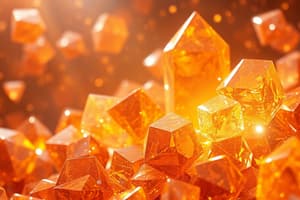Podcast
Questions and Answers
Which property of crystalline solids is most influenced by the symmetry of the crystal lattice?
Which property of crystalline solids is most influenced by the symmetry of the crystal lattice?
- Conductivity
- Mechanical strength
- Optical properties (correct)
- Thermal expansion
In band theory, what characterizes a semiconductor compared to an insulator?
In band theory, what characterizes a semiconductor compared to an insulator?
- Broader band gap
- Smaller band gap (correct)
- Lower number of free electrons
- Higher thermal conductivity
What type of defect would most likely affect a material's electrical conductivity?
What type of defect would most likely affect a material's electrical conductivity?
- Line defects
- Atomic packing efficiency
- Planar defects
- Point defects (correct)
Which characteristic do unit cells in a crystal lattice define?
Which characteristic do unit cells in a crystal lattice define?
Which of the following describes how band structure is primarily affected?
Which of the following describes how band structure is primarily affected?
What is the impact of p-type doping on semiconductor materials?
What is the impact of p-type doping on semiconductor materials?
What distinguishes ferromagnetism from antiferromagnetism in solid materials?
What distinguishes ferromagnetism from antiferromagnetism in solid materials?
How is superconductivity characterized in materials below their critical temperature?
How is superconductivity characterized in materials below their critical temperature?
What does the Meissner effect describe in superconductors?
What does the Meissner effect describe in superconductors?
What role do crystalline structures play in the optical properties of materials?
What role do crystalline structures play in the optical properties of materials?
Flashcards
What are Semiconductors?
What are Semiconductors?
Materials with electrical conductivity between conductors and insulators, essential for transistors and circuits.
Doping
Doping
Adding impurities to a semiconductor to change its conductivity. 'p-type' introduces holes for positive charge flow, while 'n-type' adds excess electrons for negative charge flow.
Ferromagnetism
Ferromagnetism
A type of magnetism where materials have strong magnetic ordering, resulting in a strong magnetic field.
Superconductivity
Superconductivity
Signup and view all the flashcards
Meissner Effect
Meissner Effect
Signup and view all the flashcards
Study Notes
Introduction to Solid State Physics
- Solid-state physics explores the physical properties of solids, studying the behavior of electrons, atoms, and ions within them.
- It's an interdisciplinary field drawing on quantum mechanics, electromagnetism, and thermodynamics.
- Solid-state physics has revolutionized technology, leading to advancements like transistors, lasers, and semiconductors.
- Understanding how atomic arrangements affect a solid's electrical, optical, and magnetic properties is central to the field.
- Many-body interactions are frequently encountered in these studies.
Crystalline Solids
- Crystalline solids possess a repeating three-dimensional pattern of atoms, ions, or molecules, called a crystal lattice.
- The symmetry of this lattice strongly influences the material's properties.
- Crystalline structures include cubic, hexagonal, and tetragonal, each with unique characteristics.
- The different forms in which materials crystallize affect their properties.
Crystal Structure
- Crystal structure describes the systematic arrangement of atoms within a crystalline solid.
- Knowing the crystal structure allows for predictions about material behavior.
- Unit cells are fundamental repeating units within the crystal lattice.
- Crystal structures vary, exhibiting different symmetries and atomic arrangements.
Lattice Defects
- Lattice defects are deviations from the perfect crystalline arrangement.
- These imperfections can significantly alter the material's properties.
- Defect types include point defects (vacancies, interstitials, substitutions), line defects (dislocations), and planar defects (grain boundaries).
- Point defects affect electrical conductivity and diffusion.
- Line defects influence plasticity and strength.
- Planar defects impact mechanical and electrical behavior.
Band Theory
- Band theory explains the allowed energy levels for electrons in a solid.
- Electron energy levels are grouped into bands, separating allowed energy ranges.
- This band structure is heavily influenced by periodic potential.
- Electron occupancy of the valence band determines whether a material is an insulator, semiconductor, or conductor.
- The band gap is the energy difference between valence and conduction bands, influencing optical and electrical properties.
- Semiconductors have smaller band gaps compared to insulators.
Semiconductor Materials
- Semiconductors exhibit electrical conductivity between conductors and insulators, crucial for devices like transistors and integrated circuits.
- Doping (adding impurities) alters conductivity.
- p-type doping introduces holes (positive charge carriers), increasing conductivity.
- n-type doping introduces excess electrons (negative charge carriers), also increasing conductivity.
Magnetic Properties
- Solids exhibit various magnetic behaviors, including diamagnetism, paramagnetism, ferromagnetism, and antiferromagnetism.
- Ferromagnetism shows strong magnetic ordering, while antiferromagnetism displays alternating spins.
- Magnetic properties stem from electron spin arrangements and interactions.
- Magnetic materials are employed in data storage and sensors.
Superconductivity
- Superconductivity is the phenomenon of zero electrical resistance in certain materials below a critical temperature.
- This leads to unique properties and applications.
- The Meissner effect, where superconductors expel magnetic fields, is a key characteristic.
- The BCS theory explains the mechanism of superconductivity in many materials.
- High-temperature superconductors exhibit critical temperatures above 77 K, offering potential for broader applications.
Optical Properties
- Optical properties describe how materials interact with light, focusing on absorption, reflection, and transmission.
- Crystalline structure significantly affects optical behavior.
- Optical properties help characterize materials and are essential for devices like solar cells.
Other Topics
- Dielectric and piezoelectric properties
- Phonons and lattice vibrations
- Diffusion in solids
- Surface physics
- Nanomaterials
- Experimental techniques are crucial in studying solid-state materials.
Studying That Suits You
Use AI to generate personalized quizzes and flashcards to suit your learning preferences.



